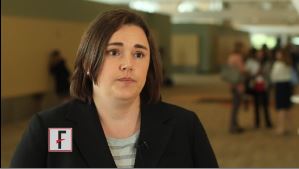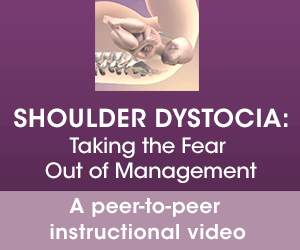User login
VIDEO: Childhood obesity, particularly severe obesity, is not declining
BALTIMORE – Rates of obesity, particularly severe obesity, in children have not decreased since 1999, despite what recent studies may say, according to a study presented at the annual meeting of the Pediatric Academic Societies.
“Overall, there is no evidence of a decrease in obesity in any of our age groups,” said Asheley C. Skinner, Ph.D., of Duke University in Durham, N.C., adding that “we see a sort of consistent, ongoing increase up through 2014 for severe obesity and regular class I obesity for all of our age groups.”
In a video interview, Dr. Skinner discussed the findings of her study, in which data from the National Health and Nutrition Examination Survey (NHANES) from the years 1999-2014 were examined to determine obesity in children aged 2-19 years. A combination of body mass index (BMI) and “a percentage of the 95th percentile” of weight across three age groups – 2-5 years, 6-11 years, and 12-19 years – was used to classify children with class I, class II, or class III (severe) obesity.
Dr. Skinner did not report any relevant financial disclosures.
The video associated with this article is no longer available on this site. Please view all of our videos on the MDedge YouTube channel
BALTIMORE – Rates of obesity, particularly severe obesity, in children have not decreased since 1999, despite what recent studies may say, according to a study presented at the annual meeting of the Pediatric Academic Societies.
“Overall, there is no evidence of a decrease in obesity in any of our age groups,” said Asheley C. Skinner, Ph.D., of Duke University in Durham, N.C., adding that “we see a sort of consistent, ongoing increase up through 2014 for severe obesity and regular class I obesity for all of our age groups.”
In a video interview, Dr. Skinner discussed the findings of her study, in which data from the National Health and Nutrition Examination Survey (NHANES) from the years 1999-2014 were examined to determine obesity in children aged 2-19 years. A combination of body mass index (BMI) and “a percentage of the 95th percentile” of weight across three age groups – 2-5 years, 6-11 years, and 12-19 years – was used to classify children with class I, class II, or class III (severe) obesity.
Dr. Skinner did not report any relevant financial disclosures.
The video associated with this article is no longer available on this site. Please view all of our videos on the MDedge YouTube channel
BALTIMORE – Rates of obesity, particularly severe obesity, in children have not decreased since 1999, despite what recent studies may say, according to a study presented at the annual meeting of the Pediatric Academic Societies.
“Overall, there is no evidence of a decrease in obesity in any of our age groups,” said Asheley C. Skinner, Ph.D., of Duke University in Durham, N.C., adding that “we see a sort of consistent, ongoing increase up through 2014 for severe obesity and regular class I obesity for all of our age groups.”
In a video interview, Dr. Skinner discussed the findings of her study, in which data from the National Health and Nutrition Examination Survey (NHANES) from the years 1999-2014 were examined to determine obesity in children aged 2-19 years. A combination of body mass index (BMI) and “a percentage of the 95th percentile” of weight across three age groups – 2-5 years, 6-11 years, and 12-19 years – was used to classify children with class I, class II, or class III (severe) obesity.
Dr. Skinner did not report any relevant financial disclosures.
The video associated with this article is no longer available on this site. Please view all of our videos on the MDedge YouTube channel
AT THE PAS ANNUAL MEETING
Webcast: Providing LARC methods of contraception to adolescents
The video associated with this article is no longer available on this site. Please view all of our videos on the MDedge YouTube channel
Access Dr. Burkman's Webcasts on contraception:
- Emergency contraception: How to choose the right one for your patient
- Contraceptive considerations for women with headache and migraine
- Hormonal contraception and risk of venous thromboembolism
- Oral contraceptives and breast cancer: What’s the risk?
- Factors that contribute to overall contraceptive efficacy and risks
- Obesity and contraceptive efficacy and risks
- How to use the CDC's online tools to manage complex cases in contraception
Helpful resources for your practice:
- United States Medical Eligibility Criteria for Contraceptive Use, 2016
- United States Medical Eligibility Criteria (US MEC) for Contraceptive Use, 2010
- Summary Chart of US Medical Eligibility for Contraceptive Use
- Book recommendation: Allen RH, Cwiak CA, eds. Contraception for the medically challenging patient. New York, New York: Springer New York; 2014.
The video associated with this article is no longer available on this site. Please view all of our videos on the MDedge YouTube channel
Access Dr. Burkman's Webcasts on contraception:
- Emergency contraception: How to choose the right one for your patient
- Contraceptive considerations for women with headache and migraine
- Hormonal contraception and risk of venous thromboembolism
- Oral contraceptives and breast cancer: What’s the risk?
- Factors that contribute to overall contraceptive efficacy and risks
- Obesity and contraceptive efficacy and risks
- How to use the CDC's online tools to manage complex cases in contraception
Helpful resources for your practice:
- United States Medical Eligibility Criteria for Contraceptive Use, 2016
- United States Medical Eligibility Criteria (US MEC) for Contraceptive Use, 2010
- Summary Chart of US Medical Eligibility for Contraceptive Use
- Book recommendation: Allen RH, Cwiak CA, eds. Contraception for the medically challenging patient. New York, New York: Springer New York; 2014.
The video associated with this article is no longer available on this site. Please view all of our videos on the MDedge YouTube channel
Access Dr. Burkman's Webcasts on contraception:
- Emergency contraception: How to choose the right one for your patient
- Contraceptive considerations for women with headache and migraine
- Hormonal contraception and risk of venous thromboembolism
- Oral contraceptives and breast cancer: What’s the risk?
- Factors that contribute to overall contraceptive efficacy and risks
- Obesity and contraceptive efficacy and risks
- How to use the CDC's online tools to manage complex cases in contraception
Helpful resources for your practice:
- United States Medical Eligibility Criteria for Contraceptive Use, 2016
- United States Medical Eligibility Criteria (US MEC) for Contraceptive Use, 2010
- Summary Chart of US Medical Eligibility for Contraceptive Use
- Book recommendation: Allen RH, Cwiak CA, eds. Contraception for the medically challenging patient. New York, New York: Springer New York; 2014.
VIDEO: Comanagement effective at treating mental health issues in pediatric patients
BALTIMORE – For pediatric group practices to move toward comanagement to more effectively treat any mental health issues their patients may exhibit, the first step is to educate pediatricians about the benefits of comanagement, according to a study presented at the annual meeting of the Pediatric Academic Societies.
“Pediatricians who had had at least 4 weeks of developmental behavioral pediatrics – or had targeted training on treatment for ADHD, anxiety, depression, behavioral problems – were more likely to comanage at least 50% of their patients” with mental health disorders, explained Dr. Cori Green of Cornell University, New York.
In a video interview, Dr. Green discussed the findings of her study, which consisted of 305 group practices in the 2013 American Academy of Pediatrics Periodic Survey, and the importance of education in teaching residents, trainees, and fellows about comanagement.
Dr. Green did not report any relevant financial disclosures.
The video associated with this article is no longer available on this site. Please view all of our videos on the MDedge YouTube channel
BALTIMORE – For pediatric group practices to move toward comanagement to more effectively treat any mental health issues their patients may exhibit, the first step is to educate pediatricians about the benefits of comanagement, according to a study presented at the annual meeting of the Pediatric Academic Societies.
“Pediatricians who had had at least 4 weeks of developmental behavioral pediatrics – or had targeted training on treatment for ADHD, anxiety, depression, behavioral problems – were more likely to comanage at least 50% of their patients” with mental health disorders, explained Dr. Cori Green of Cornell University, New York.
In a video interview, Dr. Green discussed the findings of her study, which consisted of 305 group practices in the 2013 American Academy of Pediatrics Periodic Survey, and the importance of education in teaching residents, trainees, and fellows about comanagement.
Dr. Green did not report any relevant financial disclosures.
The video associated with this article is no longer available on this site. Please view all of our videos on the MDedge YouTube channel
BALTIMORE – For pediatric group practices to move toward comanagement to more effectively treat any mental health issues their patients may exhibit, the first step is to educate pediatricians about the benefits of comanagement, according to a study presented at the annual meeting of the Pediatric Academic Societies.
“Pediatricians who had had at least 4 weeks of developmental behavioral pediatrics – or had targeted training on treatment for ADHD, anxiety, depression, behavioral problems – were more likely to comanage at least 50% of their patients” with mental health disorders, explained Dr. Cori Green of Cornell University, New York.
In a video interview, Dr. Green discussed the findings of her study, which consisted of 305 group practices in the 2013 American Academy of Pediatrics Periodic Survey, and the importance of education in teaching residents, trainees, and fellows about comanagement.
Dr. Green did not report any relevant financial disclosures.
The video associated with this article is no longer available on this site. Please view all of our videos on the MDedge YouTube channel
AT THE PAS ANNUAL MEETING
Children with internalizing symptoms may not get enough attention
BALTIMORE – Children who exhibit only internalizing symptoms, which are often indicative of anxiety and depression, are less likely to be referred to mental health services than children who exhibit not only the same internalizing behavior, but also external and attentional behavior.
“Pediatricians now are doing much more about mental health; we’ve been energized about how this is an important determinant not only of the child’s present health, but the child’s long-term health, and how they function in the world,” explained Dr. Diane Bloomfield of The Children’s Hospital at Montefiore, Bronx, N.Y., at the annual meeting of the Pediatric Academic Societies.
In a video interview, Dr. Bloomfield discussed the importance of making sure children with internalizing symptoms are referred to the proper specialists, how electronic health records can play a part in children slipping through the cracks, and why educating parents is a critical step in addressing the needs of internalizing children.
Dr. Bloomfield did not report any relevant financial disclosures.
The video associated with this article is no longer available on this site. Please view all of our videos on the MDedge YouTube channel
BALTIMORE – Children who exhibit only internalizing symptoms, which are often indicative of anxiety and depression, are less likely to be referred to mental health services than children who exhibit not only the same internalizing behavior, but also external and attentional behavior.
“Pediatricians now are doing much more about mental health; we’ve been energized about how this is an important determinant not only of the child’s present health, but the child’s long-term health, and how they function in the world,” explained Dr. Diane Bloomfield of The Children’s Hospital at Montefiore, Bronx, N.Y., at the annual meeting of the Pediatric Academic Societies.
In a video interview, Dr. Bloomfield discussed the importance of making sure children with internalizing symptoms are referred to the proper specialists, how electronic health records can play a part in children slipping through the cracks, and why educating parents is a critical step in addressing the needs of internalizing children.
Dr. Bloomfield did not report any relevant financial disclosures.
The video associated with this article is no longer available on this site. Please view all of our videos on the MDedge YouTube channel
BALTIMORE – Children who exhibit only internalizing symptoms, which are often indicative of anxiety and depression, are less likely to be referred to mental health services than children who exhibit not only the same internalizing behavior, but also external and attentional behavior.
“Pediatricians now are doing much more about mental health; we’ve been energized about how this is an important determinant not only of the child’s present health, but the child’s long-term health, and how they function in the world,” explained Dr. Diane Bloomfield of The Children’s Hospital at Montefiore, Bronx, N.Y., at the annual meeting of the Pediatric Academic Societies.
In a video interview, Dr. Bloomfield discussed the importance of making sure children with internalizing symptoms are referred to the proper specialists, how electronic health records can play a part in children slipping through the cracks, and why educating parents is a critical step in addressing the needs of internalizing children.
Dr. Bloomfield did not report any relevant financial disclosures.
The video associated with this article is no longer available on this site. Please view all of our videos on the MDedge YouTube channel
AT THE PAS ANNUAL MEETING
VIDEO: Despite advances, Alzheimer’s remains a tricky diagnosis
BETHESDA, MD. – Alzheimer’s disease is not a one-size-fits-all diagnosis.
As part of a large family of related dementias, it presents some diagnostic conundrums that often make for quite a tricky clinical picture. And with not a single objective diagnostic tool, Alzheimer’s is quite often misdiagnosed, Dr. Gwen Windham said at Alzheimer’s Disease-Related Dementias 2016 Summit, sponsored by the National Institutes of Health. The rigors of primary care exert an additional influence on accurate diagnosis, said Dr. Windham of the University of Mississippi, Jackson. These busy jugglers, who have to manage a host of chronic and acute problems, may miss subtle signs and symptoms of an emerging dementia during a visit.
Patients can be tagged with the Alzheimer’s label for years, only to eventually discover their cognitive problems stem from an entirely different disorder. Some, like dementia with Lewy bodies, are incurable and difficult to manage. But sometimes, treatable factors can cause cognitive troubles in “Alzheimer’s” patients. The challenge, of course, is sorting it all out before the years tick by, Dr. Windham said in a video interview.
The video associated with this article is no longer available on this site. Please view all of our videos on the MDedge YouTube channel
On Twitter @alz_gal
BETHESDA, MD. – Alzheimer’s disease is not a one-size-fits-all diagnosis.
As part of a large family of related dementias, it presents some diagnostic conundrums that often make for quite a tricky clinical picture. And with not a single objective diagnostic tool, Alzheimer’s is quite often misdiagnosed, Dr. Gwen Windham said at Alzheimer’s Disease-Related Dementias 2016 Summit, sponsored by the National Institutes of Health. The rigors of primary care exert an additional influence on accurate diagnosis, said Dr. Windham of the University of Mississippi, Jackson. These busy jugglers, who have to manage a host of chronic and acute problems, may miss subtle signs and symptoms of an emerging dementia during a visit.
Patients can be tagged with the Alzheimer’s label for years, only to eventually discover their cognitive problems stem from an entirely different disorder. Some, like dementia with Lewy bodies, are incurable and difficult to manage. But sometimes, treatable factors can cause cognitive troubles in “Alzheimer’s” patients. The challenge, of course, is sorting it all out before the years tick by, Dr. Windham said in a video interview.
The video associated with this article is no longer available on this site. Please view all of our videos on the MDedge YouTube channel
On Twitter @alz_gal
BETHESDA, MD. – Alzheimer’s disease is not a one-size-fits-all diagnosis.
As part of a large family of related dementias, it presents some diagnostic conundrums that often make for quite a tricky clinical picture. And with not a single objective diagnostic tool, Alzheimer’s is quite often misdiagnosed, Dr. Gwen Windham said at Alzheimer’s Disease-Related Dementias 2016 Summit, sponsored by the National Institutes of Health. The rigors of primary care exert an additional influence on accurate diagnosis, said Dr. Windham of the University of Mississippi, Jackson. These busy jugglers, who have to manage a host of chronic and acute problems, may miss subtle signs and symptoms of an emerging dementia during a visit.
Patients can be tagged with the Alzheimer’s label for years, only to eventually discover their cognitive problems stem from an entirely different disorder. Some, like dementia with Lewy bodies, are incurable and difficult to manage. But sometimes, treatable factors can cause cognitive troubles in “Alzheimer’s” patients. The challenge, of course, is sorting it all out before the years tick by, Dr. Windham said in a video interview.
The video associated with this article is no longer available on this site. Please view all of our videos on the MDedge YouTube channel
On Twitter @alz_gal
EXPERT ANALYSIS FROM ADRD Summit 2016
VIDEO: Adding ixazomib to len-dex boosts progression-free survival in multiple myeloma
Adding ixazomib to lenalidomide and dexamethasone was associated with longer progression-free survival and limited additional toxic effects in patients with multiple myeloma, based on the published phase 3 results of the TOURMALINE trial.
The double-blind, placebo-controlled trial included 722 patients who had relapsed, refractory, or relapsed and refractory multiple myeloma and were randomly assigned to receive the oral proteasome inhibitor plus lenalidomide-dexamethasone or placebo plus lenalidomide-dexamethasone (len-dex), according to Dr. Philippe Moreau of University Hospital Hôtel
Dieu, Nantes, France, and his colleagues in the TOURMALINE-MM1 Study Group.
At a median follow-up of nearly 14.7 months, median progression-free survival was 20.6 months in the ixazomib plus len-dex group and 14.7 months in the placebo plus len-dex group, a significant difference for ixazomib with a 0.74 hazard ratio for disease progression or death (P = .01). The benefit was noted for all prespecified patient subgroups, including patients with high-risk cytogenetic abnormalities. The overall rates of response were 78% in the ixazomib plus len-dex group and 72% in the placebo plus len-dex group, and the corresponding rates of complete response plus very good partial response were 48% and 39%, respectively. At a median follow-up of approximately 23 months, the median duration of response was 20.5 months for ixazomib plus len-dex and 15 months for len-dex alone, the researchers reported (N Engl J Med. 2016;374:1621-34. doi: 10.1056/NEJMoa1516282).
The rates of serious adverse events were 47% in the ixazomib plus len-dex group and 49% in the placebo plus len-dex group; the rates of death during the study period were 4% and 6%, respectively.
The results of the trial also were presented at the annual meeting of the American Society of Hematology, where Dr. Shaji Kumar, one the study investigators, discussed the implications of the TOURMALINE results in a video interview.
The study was sponsored by Millennium Pharmaceuticals, the makers of ixazomib (Ninlaro). Dr. Moreau reports receiving fees for serving on advisory boards for Millennium Pharmaceuticals and several other drug companies.
The video associated with this article is no longer available on this site. Please view all of our videos on the MDedge YouTube channel
On Twitter @maryjodales
Adding ixazomib to lenalidomide and dexamethasone was associated with longer progression-free survival and limited additional toxic effects in patients with multiple myeloma, based on the published phase 3 results of the TOURMALINE trial.
The double-blind, placebo-controlled trial included 722 patients who had relapsed, refractory, or relapsed and refractory multiple myeloma and were randomly assigned to receive the oral proteasome inhibitor plus lenalidomide-dexamethasone or placebo plus lenalidomide-dexamethasone (len-dex), according to Dr. Philippe Moreau of University Hospital Hôtel
Dieu, Nantes, France, and his colleagues in the TOURMALINE-MM1 Study Group.
At a median follow-up of nearly 14.7 months, median progression-free survival was 20.6 months in the ixazomib plus len-dex group and 14.7 months in the placebo plus len-dex group, a significant difference for ixazomib with a 0.74 hazard ratio for disease progression or death (P = .01). The benefit was noted for all prespecified patient subgroups, including patients with high-risk cytogenetic abnormalities. The overall rates of response were 78% in the ixazomib plus len-dex group and 72% in the placebo plus len-dex group, and the corresponding rates of complete response plus very good partial response were 48% and 39%, respectively. At a median follow-up of approximately 23 months, the median duration of response was 20.5 months for ixazomib plus len-dex and 15 months for len-dex alone, the researchers reported (N Engl J Med. 2016;374:1621-34. doi: 10.1056/NEJMoa1516282).
The rates of serious adverse events were 47% in the ixazomib plus len-dex group and 49% in the placebo plus len-dex group; the rates of death during the study period were 4% and 6%, respectively.
The results of the trial also were presented at the annual meeting of the American Society of Hematology, where Dr. Shaji Kumar, one the study investigators, discussed the implications of the TOURMALINE results in a video interview.
The study was sponsored by Millennium Pharmaceuticals, the makers of ixazomib (Ninlaro). Dr. Moreau reports receiving fees for serving on advisory boards for Millennium Pharmaceuticals and several other drug companies.
The video associated with this article is no longer available on this site. Please view all of our videos on the MDedge YouTube channel
On Twitter @maryjodales
Adding ixazomib to lenalidomide and dexamethasone was associated with longer progression-free survival and limited additional toxic effects in patients with multiple myeloma, based on the published phase 3 results of the TOURMALINE trial.
The double-blind, placebo-controlled trial included 722 patients who had relapsed, refractory, or relapsed and refractory multiple myeloma and were randomly assigned to receive the oral proteasome inhibitor plus lenalidomide-dexamethasone or placebo plus lenalidomide-dexamethasone (len-dex), according to Dr. Philippe Moreau of University Hospital Hôtel
Dieu, Nantes, France, and his colleagues in the TOURMALINE-MM1 Study Group.
At a median follow-up of nearly 14.7 months, median progression-free survival was 20.6 months in the ixazomib plus len-dex group and 14.7 months in the placebo plus len-dex group, a significant difference for ixazomib with a 0.74 hazard ratio for disease progression or death (P = .01). The benefit was noted for all prespecified patient subgroups, including patients with high-risk cytogenetic abnormalities. The overall rates of response were 78% in the ixazomib plus len-dex group and 72% in the placebo plus len-dex group, and the corresponding rates of complete response plus very good partial response were 48% and 39%, respectively. At a median follow-up of approximately 23 months, the median duration of response was 20.5 months for ixazomib plus len-dex and 15 months for len-dex alone, the researchers reported (N Engl J Med. 2016;374:1621-34. doi: 10.1056/NEJMoa1516282).
The rates of serious adverse events were 47% in the ixazomib plus len-dex group and 49% in the placebo plus len-dex group; the rates of death during the study period were 4% and 6%, respectively.
The results of the trial also were presented at the annual meeting of the American Society of Hematology, where Dr. Shaji Kumar, one the study investigators, discussed the implications of the TOURMALINE results in a video interview.
The study was sponsored by Millennium Pharmaceuticals, the makers of ixazomib (Ninlaro). Dr. Moreau reports receiving fees for serving on advisory boards for Millennium Pharmaceuticals and several other drug companies.
The video associated with this article is no longer available on this site. Please view all of our videos on the MDedge YouTube channel
On Twitter @maryjodales
FROM NEJM
Key clinical point: Adding ixazomib to lenalidomide and dexamethasone was associated with a longer progression-free survival and limited additional toxic effects in patients with multiple myeloma.
Major finding: At a median follow-up of nearly 14.7 months, median progression-free survival was 20.6 months in the ixazomib plus len-dex group and 14.7 months in the placebo plus len-dex group.
Data source: Phase III results on 722 patients in the TOURMALINE trial.
Disclosures: The study was sponsored by Millennium Pharmaceuticals, the makers of ixazomib (Ninlaro). Dr. Moreau reports receiving fees for serving on advisory boards for Millennium Pharmaceuticals and several other drug companies.
Ilo Leppik, MD
The video associated with this article is no longer available on this site. Please view all of our videos on the MDedge YouTube channel
The video associated with this article is no longer available on this site. Please view all of our videos on the MDedge YouTube channel
The video associated with this article is no longer available on this site. Please view all of our videos on the MDedge YouTube channel
Post-surgical cognitive decline hits women hardest
The video associated with this article is no longer available on this site. Please view all of our videos on the MDedge YouTube channel
The video associated with this article is no longer available on this site. Please view all of our videos on the MDedge YouTube channel
The video associated with this article is no longer available on this site. Please view all of our videos on the MDedge YouTube channel
Shoulder dystocia: Taking the fear out of management
VIDEO: How to personalize pain management in era of opioids
WASHINGTON – As the prescription opioid crisis rages, how physicians evaluate, define, and treat chronic pain is evolving.
“In the science books, there’s a definition of pain,” explained Dr. Patrice Harris, psychiatrist and chair of the American Medical Association’s Task Force to Reduce Prescription Opioid Abuse. But how individuals actually perceive pain in different situations is very complex. No matter what kind of measuring tool physicians apply, she noted, “pain is going to be personal.”
In a candid interview, Dr. Harris discussed the limitation of pain scales, the value of conversations between physicians and their patients, and the importance of cultural competency to alleviate suffering and avoid unintentional harm.
The video associated with this article is no longer available on this site. Please view all of our videos on the MDedge YouTube channel
On Twitter @whitneymcknight
WASHINGTON – As the prescription opioid crisis rages, how physicians evaluate, define, and treat chronic pain is evolving.
“In the science books, there’s a definition of pain,” explained Dr. Patrice Harris, psychiatrist and chair of the American Medical Association’s Task Force to Reduce Prescription Opioid Abuse. But how individuals actually perceive pain in different situations is very complex. No matter what kind of measuring tool physicians apply, she noted, “pain is going to be personal.”
In a candid interview, Dr. Harris discussed the limitation of pain scales, the value of conversations between physicians and their patients, and the importance of cultural competency to alleviate suffering and avoid unintentional harm.
The video associated with this article is no longer available on this site. Please view all of our videos on the MDedge YouTube channel
On Twitter @whitneymcknight
WASHINGTON – As the prescription opioid crisis rages, how physicians evaluate, define, and treat chronic pain is evolving.
“In the science books, there’s a definition of pain,” explained Dr. Patrice Harris, psychiatrist and chair of the American Medical Association’s Task Force to Reduce Prescription Opioid Abuse. But how individuals actually perceive pain in different situations is very complex. No matter what kind of measuring tool physicians apply, she noted, “pain is going to be personal.”
In a candid interview, Dr. Harris discussed the limitation of pain scales, the value of conversations between physicians and their patients, and the importance of cultural competency to alleviate suffering and avoid unintentional harm.
The video associated with this article is no longer available on this site. Please view all of our videos on the MDedge YouTube channel
On Twitter @whitneymcknight








